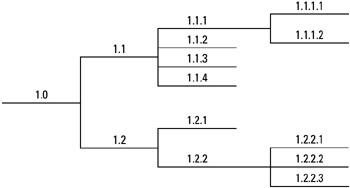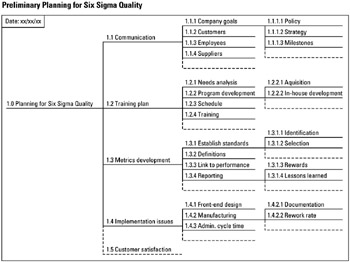Tool 204: Tree Diagram
Tool description
A tree diagram systematically maps out the detail of smaller activities required to complete a project or reach a primary goal. This tool helps to break down the complexity by logically identifying lower levels of tasks or elements. As a planning tool, it reflects all necessary activities and supporting means to successfully implement a program.
Typical application
-
To logically branch out or flow down levels of detail of projects, problems, or primary goals.
-
To break down large activities or goals into smaller and specific tasks.
Problem-solving phase
| → | Select and define problem or opportunity |
| → | Identify and analyze causes or potential change |
| → | Develop and plan possible solutions or change |
| Implement and evaluate solution or change | |
| Measure and report solution or change results | |
| Recognize and reward team efforts |
Typically used by
| Research/statistics | |
| Creativity/innovation | |
| Engineering | |
| 2 | Project management |
| Manufacturing | |
| Marketing/sales | |
| 3 | Administration/documentation |
| Servicing/support | |
| 4 | Customer/quality metrics |
| 1 | Change management |
before
-
Affinity Diagram
-
Interrelationship Digraph (I.D.)
-
Systems Analysis Diagram
-
Symbolic Flowchart
-
Prioritization Matrix
after
-
Activity Network Diagram
-
Process Decision Program Chart
-
Matrix Diagram
-
Five Whys
-
What-If Analysis
Notes and key points
-
Numerical indexing example: Levels of detail.

Step-by-step procedure
-
STEP 1 First, determine the project, problem, or primary goal for the tree diagram. This is the first level of detail. See example Preliminary Planning for Six Sigma Quality.
-
STEP 2 Identify the major areas or activities that need to be considered and indicate these as branch headings for the second level of detail.
-
STEP 3 Continue to break down major areas (branches) into smaller tasks or elements, labeling each branch as shown. This is the third level, etc.
-
STEP 4 Continue this detailing as required to create lower level branches. At this point, if using the tree diagram as a problem-solving tool, start to identify and circle most likely causes of the problems.
-
STEP 5 Verify the tree diagram by retracing the branches to the lowest level, checking the logic and flow of activities, and subtasks of supporting elements.
-
STEP 6 Encode or designate each branch in accordance with the numbering schema shown in notes and key points. Date the diagram.
Example of tool application

EAN: 2147483647
Pages: 326